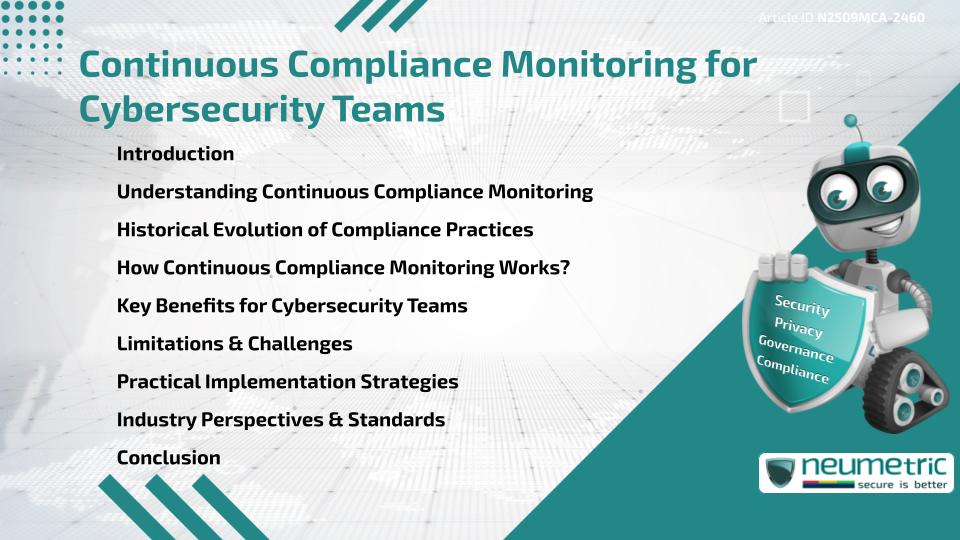Table of Contents
ToggleIntroduction
Continuous compliance monitoring is a proactive approach that helps Cybersecurity teams maintain regulatory alignment, reduce Risks & build Stakeholder trust. Unlike periodic audits that provide snapshots, this method ensures real-time oversight of Policies, controls & Risks across an organisation’s digital environment. It strengthens defenses against Cyber Threats, simplifies regulatory reporting & improves operational efficiency. As Compliance Requirements grow more complex, continuous compliance monitoring offers a practical solution for Organisations to stay ahead.
Understanding Continuous Compliance Monitoring
Continuous compliance monitoring is the process of consistently checking systems, controls & processes to ensure compliance with security regulations & standards. It enables Organisations to detect & address issues in real time rather than waiting for scheduled audits. This constant vigilance helps prevent lapses that could lead to data breaches, penalties or reputational damage.
For example, just as cars use sensors to monitor speed & fuel efficiency, continuous compliance monitoring uses automated tools to track & report compliance across IT environments.
Historical Evolution of Compliance Practices
Traditionally, Organisations relied on annual or quarterly audits to demonstrate compliance. These audits were labor-intensive & often revealed issues long after they occurred. As digital systems expanded & Threats grew, this model became less effective. Continuous compliance monitoring emerged in response to the demand for real-time visibility & proactive management. It shifted compliance from being a periodic obligation to an ongoing business function.
How Continuous Compliance Monitoring Works?
This approach relies heavily on automation. Software tools integrate with cloud services, servers & endpoints to track compliance metrics. Alerts are generated when deviations occur, enabling quick remediation. Dashboards & reporting functions provide visibility for both technical staff & executives. Key aspects include:
- Automated data collection
- Real-time Risk detection
- Integration with existing security frameworks
- Continuous reporting to meet Regulatory Standards
Key Benefits for Cybersecurity Teams
For Cybersecurity teams, continuous compliance monitoring provides several advantages:
- Reduced Risk: Early detection of non-compliance prevents larger Security Incidents.
- Operational efficiency: Automation reduces the burden of manual audits.
- Improved trust: Transparency builds confidence among Stakeholders, partners & regulators.
- Scalability: Teams can monitor compliance across large, complex IT environments.
Limitations & Challenges
Despite its advantages, continuous compliance monitoring faces some challenges:
- Cost: Implementation may require significant investment in tools & training.
- Complexity: Integrating Monitoring Tools into legacy systems can be difficult.
- False positives: Automated alerts may overwhelm teams if not properly calibrated.
- Human oversight: Automation reduces but does not eliminate the need for expert review.
Practical Implementation Strategies
To adopt continuous compliance monitoring successfully, Organisations should:
- Conduct a Gap Analysis to identify compliance priorities
- Choose tools that integrate well with existing systems
- Train staff to interpret automated alerts effectively
- Establish clear workflows for remediation & reporting
Starting small & scaling gradually often helps Organisations manage complexity & control costs.
Industry Perspectives & Standards
Many industries now view continuous compliance monitoring as a best practice. For example, Financial institutions use it to meet stringent SOX requirements, while Healthcare providers rely on it for HIPAA compliance. Frameworks such as NIST & ISO 27001 also align with the principles of continuous oversight, reinforcing its role in Cybersecurity Governance.
Conclusion
Continuous compliance monitoring empowers Cybersecurity teams to keep pace with evolving Threats & regulatory demands. By combining automation with human expertise, it strengthens security posture, reduces Risks & builds organizational resilience.
Takeaways
- Continuous compliance monitoring shifts compliance from periodic audits to real-time oversight.
- It reduces Risks, increases efficiency & fosters trust.
- Successful implementation requires planning, the right tools & skilled personnel.
- Despite challenges, it has become a cornerstone of modern Cybersecurity practices.
FAQ
What is continuous compliance monitoring?
It is the ongoing process of using automated tools to track & maintain Regulatory Compliance across IT systems in real time.
Why is continuous compliance monitoring important for Cybersecurity teams?
It provides early detection of Risks, reduces manual workloads & ensures ongoing alignment with security regulations.
How does continuous compliance monitoring differ from traditional audits?
Traditional audits provide periodic snapshots, while Continuous Monitoring offers real-time visibility & proactive management.
What tools are used for continuous compliance monitoring?
Tools include cloud monitoring software, automated reporting systems & integrations with security frameworks.
Can continuous compliance monitoring replace human oversight?
No. Automation reduces manual effort but expert review is still necessary to interpret findings & make decisions.
What industries benefit most from continuous compliance monitoring?
Industries with strict regulations such as Finance, Healthcare & Government agencies benefit the most.
What are the biggest challenges in adopting continuous compliance monitoring?
High costs, integration difficulties & managing false positives are common challenges.
Need help for Security, Privacy, Governance & VAPT?
Neumetric provides organisations the necessary help to achieve their Cybersecurity, Compliance, Governance, Privacy, Certifications & Pentesting needs.
Organisations & Businesses, specifically those which provide SaaS & AI Solutions in the Fintech, BFSI & other regulated sectors, usually need a Cybersecurity Partner for meeting & maintaining the ongoing Security & Privacy needs & requirements of their Enterprise Clients & Privacy conscious Customers.
SOC 2, ISO 27001, ISO 42001, NIST, HIPAA, HECVAT, EU GDPR are some of the Frameworks that are served by Fusion – a SaaS, multimodular, multitenant, centralised, automated, Cybersecurity & Compliance Management system.
Neumetric also provides Expert Services for technical security which covers VAPT for Web Applications, APIs, iOS & Android Mobile Apps, Security Testing for AWS & other Cloud Environments & Cloud Infrastructure & other similar scopes.
Reach out to us by Email or filling out the Contact Form…


